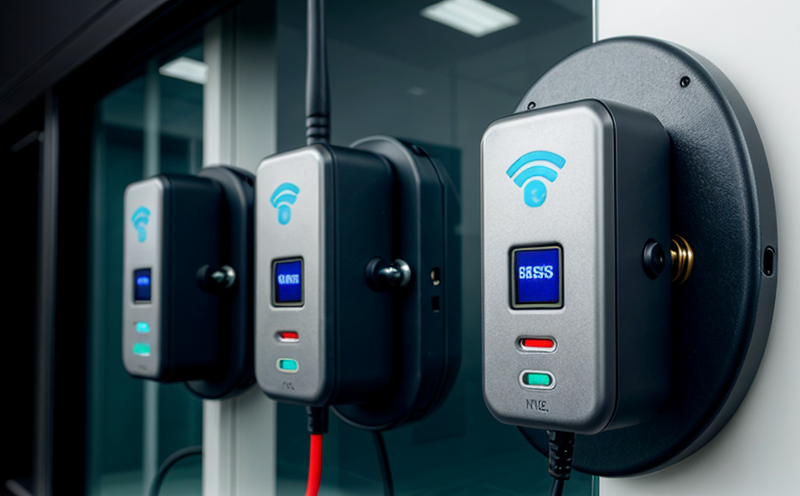IEC 60950 Safety Compliance Testing of Wireless Communication Devices
The IEC 60950 safety standard is a critical benchmark in electrical and electronic equipment manufacturing, ensuring the protection of users against harmful electrical and mechanical hazards. This standard plays a pivotal role in the design, development, and certification processes for wireless communication devices, which include smartphones, tablets, modems, routers, and other connected devices.
The safety compliance testing under IEC 60950 involves a series of rigorous checks aimed at preventing electric shocks, fires, and other hazards that could arise from the use of these devices. Compliance with this standard is mandatory for many countries around the world to ensure consumer safety and product reliability.
Our laboratory provides comprehensive testing services tailored to meet the requirements of IEC 60950. Our experienced team ensures that all test procedures are conducted in accordance with the latest international standards, including ISO and IEC guidelines. This includes a thorough examination of electrical insulation, protection against electric shock, mechanical strength, and other parameters critical to safety.
The testing process involves several key steps. Initially, our engineers assess the design specifications of the device to ensure compliance with the standard's requirements. This step is crucial as it sets the foundation for accurate and precise testing. Once the assessment is complete, we proceed with functional tests that simulate real-world conditions to evaluate the device’s performance under various scenarios.
Electrical safety checks are conducted using specialized equipment such as insulation resistance testers, ground fault circuit interrupters (GFCIs), and high-voltage generators. These tests aim to confirm that the device does not present a risk of electric shock or fire when used as intended. Mechanical integrity is tested by subjecting the device to physical stress in controlled laboratory environments.
Our laboratory also performs environmental stress screening, which involves exposing devices to extreme conditions such as high and low temperatures, humidity, and vibration. This helps identify potential weaknesses that could lead to failures under operational conditions. Additionally, we conduct electromagnetic compatibility (EMC) tests to ensure the device does not interfere with other electrical equipment in its environment.
The final phase of testing involves generating a comprehensive report detailing all findings from the various tests conducted. This document serves as evidence of compliance and is essential for regulatory approval processes. Our team works closely with clients throughout this process, providing expert advice to ensure that any issues are addressed promptly and effectively.
By adhering strictly to IEC 60950 standards during our testing procedures, we guarantee the highest level of safety for wireless communication devices. This is not only beneficial for manufacturers but also enhances consumer trust in these products by ensuring they meet global safety regulations.
Quality and Reliability Assurance
- Electrical Insulation Testing: Ensures the insulation material can withstand electrical stresses without breaking down or deteriorating.
- Shock Hazard Analysis: Identifies potential risks of electric shock to users during normal use.
- Mechanical Strength Evaluation: Tests the robustness of materials and structures against mechanical forces.
- Environmental Stress Screening: Simulates harsh environmental conditions to reveal latent defects early in production.
- EMC Testing: Guarantees that devices do not emit or receive electromagnetic interference, thereby maintaining stable communication.
The stringent nature of these tests ensures that wireless communication devices are safe and reliable for consumer use. Our laboratory employs advanced technologies and methodologies to achieve the highest standards of accuracy and consistency in our testing processes. This commitment to quality is reflected in the detailed reports we provide, which serve as valuable tools for continuous improvement.
Competitive Advantage and Market Impact
Compliance with IEC 60950 is not just a legal requirement; it also offers significant competitive advantages to manufacturers. By demonstrating adherence to this international standard, companies can ensure their products meet the highest safety standards globally. This can enhance brand reputation and customer confidence, leading to increased market share.
Moreover, compliance with IEC 60950 helps businesses avoid costly recalls and product bans that could arise from non-compliance. In today’s highly competitive market, maintaining a strong safety record is essential for long-term success. Our testing services help companies stay ahead of regulatory changes and consumer expectations, ensuring they are well-prepared to meet future challenges.
In the context of cybersecurity and technology testing, IEC 60950 plays an important role in safeguarding against potential risks posed by wireless communication devices. By focusing on electrical safety, mechanical integrity, and environmental resilience, we contribute to a safer technological ecosystem for all users.
Use Cases and Application Examples
The applications of IEC 60950 compliance testing are vast and varied across different sectors. In telecommunications, this standard ensures that devices like smartphones and routers meet stringent safety requirements before being released to the market. For manufacturers in the consumer electronics industry, compliance with these standards is crucial for maintaining a positive public image and avoiding legal issues.
Our laboratory has extensive experience working with companies in various industries, including:
- Telecommunications: Testing modems, routers, and other networking equipment.
- Consumer Electronics: Evaluating smartphones, tablets, and related accessories.
- Medical Devices: Ensuring safety in medical-grade wireless communication devices.
In each case, our testing services are designed to address specific challenges faced by these industries. For instance, in the telecommunications sector, we focus on ensuring robust signal strength while minimizing interference with other devices. In consumer electronics, emphasis is placed on user comfort and ease of use without compromising safety.





